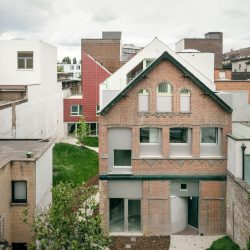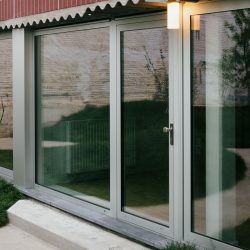
NOTAN OFFICE . photos: © Stijn Bollaert
The project is built in a dense area of Brussels, near the canal, a historically industrial area. The square facing the plot is an active urban pocket where trams, markets, school, church and public activities meet.
MICROCITY
This mixity was also very present on the given plot. On the square an old town house from the late 1800s hides two long industrial halls sharing a courtyard.
In this saturated context and by “digging” inside the built mass of the plot, a housing ensemble is created with 3 multi-oriented volumes sharing a generous common garden.
The project is an agglomeration of volumes and scales in a green area. A typical Brussels town house, its extension resembling to a roman ruin, a brick industrial façade, some rounded steps, some elements of the past constructions and the new tiled volumes; all with their private outdoor space overlooking the common garden… From the public square, as soon as the main door opens, a smooth transition between public, common and private and the flowing between the built feels like walking in a small village, a microcity.
In this idea of generating a small community, the ground floor is organised with programs that belong to everyone. The bicycle parking and a small atelier inside glass bricks are under the central volume. Semi-private gardens and living spaces articulate the common area. On this shared ground floor, all is fluid and transparent accentuating this sense of belonging to the ensemble.
GENIUS LOCI
The project respects the DNA of the place. Transforming an industrial site to housing should not kill its original identity. A promotional project in such a site should not rhyme with white plastered facades and plastic windows.
A huge attention was given to the materials. For the outdoor as well as for then the indoor, the materiality avoids any artifice. They are shown as they are and valued as ornaments. The concrete blocks have no paint, the structure is shown and the project composes with them. No half blocks, no half tiles; all fits.
On top of that many elements present on site before the project are reused, reinterpreted and reorganised. Existing doors inside the apartments, the “porphire” tiles reorganised for the outdoor path, the central building is partly supported by the former concrete structure of the former shed.
The new volumes shape is within the former sheds outlines. Setbacks where necessary to improve the living quality of each unit. This organic transformation of shapes generates peculiar spatial qualities that can only belong to that specific place. The red volume is a massive abstract volume standing on a transparent ground level. This strong identity belongs to the industrial language but also becomes adapted to housing in this environment.
The project wants to prolong the past history and respect the “spirit of the place”, it went from industry to housing but is still in an industrial environment.
INSIDE
Both new volumes inside the courtyard are against the neighbouring walls. Those walls are “inflated” in order to host all technical elements as well as circulation, kitchens, toilets and bathrooms. Living areas and bedrooms are therefore pushed towards the façade and the light.
_
DUCHESSE
REHABILITATION AND TRANSFORMATION OF INDUSTRIAL HALLES AND A TOWN HOUSE IN AN ENSEMBLE OF 8 UNITS
LOCALISATION: Molenbeek-St-Jean, Place de la Duchesse
TYPE: Rehabilitation, transformation and construction
ROLE: Full mission (conception + execution)
TYPOLOGY: Industrial hall and patrimonial town house
PHASE: Built
DATE: 2017 – 2022
CLIENT: Private
COSTS: 1.700.000€
SURFACE: 1080m2 + (450m2 outdoor)
CREDITS:
Architect and Landscape architect: NOTAN OFFICE
Engineer: Forme et Structure
Client: Private
Photos: Stijn Bollaert






























